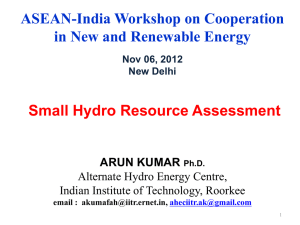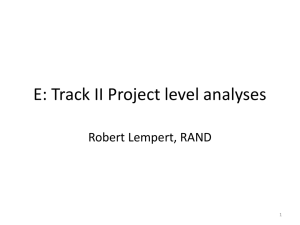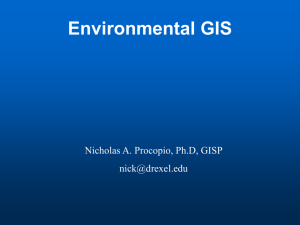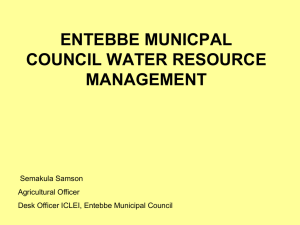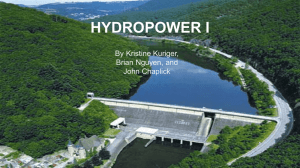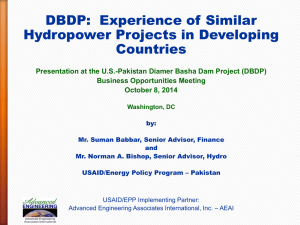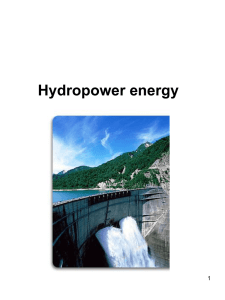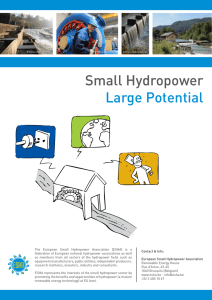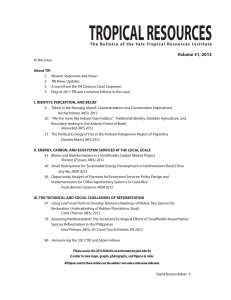Slide PPT
advertisement
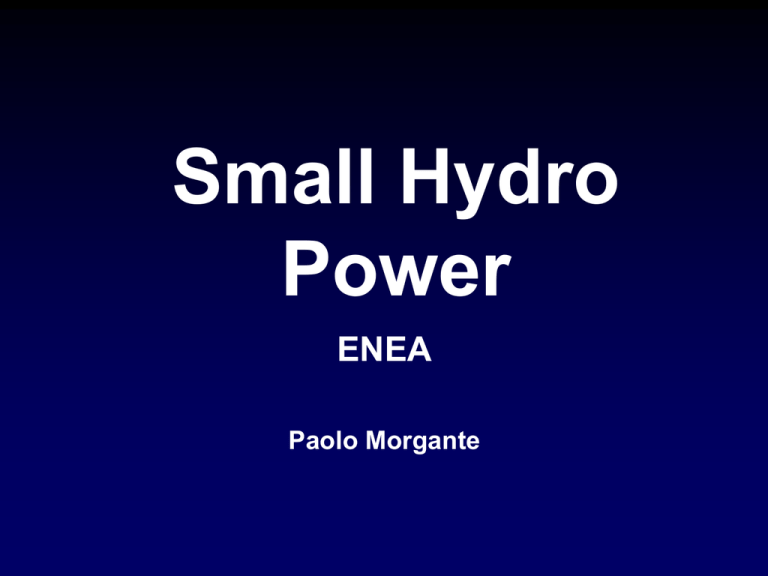
Small Hydro Power ENEA Paolo Morgante Small Hydro Power (SHP) Small Hydro Power (SHP) is hydro plant with power under 10 MW as defined by United Nations Industrial Development Organization (UNIDO): – Micro hydro plants P <100 kW – Mini hydro plants P <1.000 kW – Small hydro plants P <10.000 kW P= Power plant Scale of Hydropower Projects • • • • • • Large-hydro – More than 100 MW feeding into a large electricity grid Medium-hydro – 15* - 100 MW usually feeding a grid (*10) Small-hydro – 1 – 15* MW - usually feeding into a grid (*10) Mini-hydro – Above 100 kW, but below 1 MW – Either stand alone schemes or more often feeding into the grid Micro-hydro – From 5kW up to 100 kW (*>0) – Usually provided power for a small community or rural industry in remote areas away from the grid. Pico-hydro – From a few hundred watts up to 5kW – Remote areas away from the grid. Choice of technology and site • Small hydro technology is mature and well-established in the market • Improvements: equipment designs, differents materials, control sistem • Q=Flow of water through the pipe (m³/sec) • H=Head (m) • The Power (kW) avaiable from the flow: P=QHgη g = 9,8 m/s² η= 80% global efficency plant Hydro project schematic Hydro project schematic Types of Hydroelectric Installation Typologies of Hydropower plants a) Run of River Plants b) Pondage Plants c) Reservoir Plants Typologies of Hydropower plants a) Run of River Plants – A Run of River plant uses the available river flow – A Run of River plant has a little cumulative water – High cost Typologies of Hydropower plants b) Pondage Plants – Cumulative water flows permits storage of water for few weeks – Pondage Plant can works when the level of river is low Typology of hydropower plants c) Reservoir Plants – Energy prodution of a Reservoir Plant is based on cumulative water flows – Construction of a very large dam to cumulate water Usually this kind of plant is not a SHP Hydropower and SHP Potentials Hydropower now accounts for about 84 % of the electricity generation from renewable sources in Europe (EU-25) and for 13 % of total electricity production in the EU. In 2001, in EU-15, SHP has contribute about: – 2 % to the total electricity generation – 9 % of the RES (Renewable Energy Source) electricity generation – 4 % of the RES primary energy SHP accounts for approximately 4.6 % of total hydro generation in the new EU Member States (EU-10new2) and in the Candidate Countries (CC3). None of the other renewable energy sources (wind, biomass, photovoltaic, etc) is able to compete with small hydropower in these countries. In EU-25 about 16'800 SHP plants are in operation with a total installed capacity of 11 GW, while the total production is about 41 TWh per year. Potential for hydropower development in selected countries (World Energy Conference. UN. 2003) Country Hydro as % of total electricity Ratio of theoretical potential to actual Ratio of economic potential to actual Norway Canada India France Indonesia U.S. World tot. 100 63 25 20 14 10 19 5.77 3.81 4.2 1.15 31.3 1.82 18.3 1.8 1.54 3.0 1.0 3.1 1.3 >2.78 Plan SHP • • • • Control national and regional law Who using the water and how Story analisis of river flow Study hidrogeologic and hidrografic of site • Chek principal parameters (Q) river flow avieble and (H) head for calculate power of site • Pubblicity of project and consalting citizen. Major attributes of hydropower Positive No emissions Mature tecnology Renevable resource with higt efficienty (> 80%) Long life (40-50 years) Low maintenance costs Skilled work Change using area Negative Social impacts (land inundation, change land use) High initial capital costs: 3- 4,5 kEuro/kw Impacts on river flows and aquatic ecology Variable output-dependent on rainfall and snowfall High costs of dismission Bureaucracy Hydroelectric plants – Start easily and quickly and change power output rapidly – Complement large thermal plants (coal and nuclear), which are most efficient in serving base power loads. – Save millions of barrels of oil SHP emissions • As all other renewable energy sources, SHP plays an important role in reducing the emissions. • Externality of SHP are very low. • This is very important and positive, expecially for Kyoto protocol. How to reduce the impact of hydropower plant Impacts landscape: – Built the house power under ground – Built electric lines under ground – Use local material – The color of power house must be armony with enviromental – Check of spoon river – Little time of costruction How to reduce the impact of hydropower plant Impacts Acustic: – No noise out of power house – Try to reduce vibration in power house Externality of powerhouse: – Strain and condition air in powerhouse How to reduce the impact of hydropower plant • Impact environment: – Fish passes, temporary diversion of river – Faunistic repopulation – Backwater area • Infrastructure modification : – Use local material for new street and tecnology lines How to reduce the impact of hydropower plant • Flow river modification : – Waring level of river – Study energy production by avieble flow – Predict new scenery for production /request • Impact electromagnetic: – Power house and lines elettricy mast be underground. How to reduce the impact of hydropower plant • Impact economic: – New capital investiment – Skilled work – Services for worker (temporary) • Impatct social: – New work – Keep out population of prodution energy area – Communication to citizen (exchange of viewes) Examples of hydropower 1. Rino Power plant Italy, Adamello mountains. 2. Pols SHP plant Austria, Styria. 1. Rino Power plant • We describe a plant in a regional natural park*: it rapresents an example to be followed, both for the useful collaboration between progect staff and environmental authorities * Adamello Natural Park 1. Rino Power plant • Goal: – The impacts of power plant are very low and accept by citizen – Tanks to rigth collaboration this project received the financial support of the Europian Commission within the THERMIE A programme. 1. Rino Power plant • Good exemple of correct using bioengineeering thechniques to consolid slope • Also the basin doesn’t produce a relevant modification of landscape 1. Rino Power plant • The turist use the basin as a recreation area • For that reason near the basin there are 5 picnic sites with a car parking, and a few shops. 2. Pols SHP plants • River pols is located in Styria, Austria, in a semi-alpine region. It build in the 1991 • Rated flow 7 m3/s; net rated head 25 m • P=1520 kW;Annual production 9 GWh • Keplan Axial Turbine 2. Pols SHP plants • The project guaranteed an accettable result between ecological demand and tecnical contents • The citizen were be information of every step during costruction plant 2. Pols SHP plants • A nice idea of the owner of the site was to install a museum in the power house painted outside by children. • Lake is very clean and it is highly accepted by the population. What to do for goal with SHP Act cordinated strategy: • Informing • Including the people in the projects • Dialogue with opponents • Implementing social compain Hydroelettric and SHP Web sites • www.hydro.org • www.hidropower.org • www.ue.com The European Commission, Trasport and Energy DG TREN, 200 Rue de la Loi, B-1049 Brussels Belgium Thank you for kind attenction Paolo Morgante paolo.morgante@casaccia.enea.it Three Gorges Dam (China)

